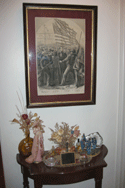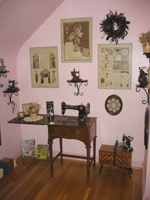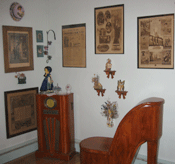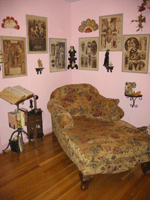Decorating With Antique Newspapers
By Maurene Mealy
The collecting of antique newspapers is an engaging way to research a
specific time period or historical event. The articles and advertisements found
in these old newspapers are actual artifacts and supporting evidence of the
importance, cultural value and original cost of items being collected. Equal
pleasure is found in collecting the printed article as well as an illustration,
cartoon or photograph. What better way is there to share them than by decorating
your home with the stories told by the journalists that actually lived the
event?
Some collectors prefer to find newspapers to accentuate a certain
subject they have been collecting, such as war events, sports or a certain
personality. However, finding items to correspond to a newspaper that you found
can be just as much fun. For example, I once discovered papers between the
floorboards of an old home which gave way to an unexpected finding of newspapers
that were all printed in 1941, after the bombing of Pearl Harbor. They had been
surprisingly well preserved and in a condition suitable for framing. This
discovery led to a WWII theme for a guest room. The framed newspapers became
wall art, which were accessorized with WWII patriotic Christmas cards,
Valentines, military sweetheart pillow covers, and the hard-to-find "Sons in
Services" flags.
Illustrated newspapers were introduced in the United States
during the 1850s. The printed illustrations were made from wood engravings in
order to be compatible with the processes of the printing press. Engravings have
the appearance of pen and ink drawings and are stunning when framed. The Civil
War theme is the focus of the foyer of my home and the stairwell to the
upstairs. Original sheet music of the same time period was also framed to
compliment it. The adjoining foyer is decorated with engravings of President
Lincoln, as well as with the artistic social commentary of the era seen in the
political cartoons of Thomas Nast.
A specialized photoengraving process
called rotogravure was created in early 1900. Although expensive for the
newspapers, the financial investment was well rewarded as the improvement in the
quality of the pictures was directly proportional to the increase in readers and
advertisers. Typically, rotogravures were included in only Sunday editions and
appeared as a collage of pictures published to illustrate social and political
events, advertisements and the conflict of World War I. The first American
newspaper to publish a rotogravure section was the New York Times in 1912, and
the technology lasted until 1919. Interesting to note is the insinuation that
rotogravure was used as propaganda to influence the U.S. entry into the Great
War. It was not uncommon to find a page that included together photographs of
prominent socialites, arts, fashion and events of the war. Rotogravure has a
distinctive vintage look perfect for Victorian décor.
Newspapers that have
been preserved can be found in antique shops, auctions, flea markets and on the
internet. When framing, use acid-free materials. Do not let the newspaper rest
directly against the glass. Keep them out of direct sunlight. Lay them flat and
unfolded when storing.
Books and information on collecting newspapers are
scarce. However, the internet can be a valuable resource. The serious collector
should try to obtain James E. Smalldon's Early American Newspa-pers: A Guide to
Collecting (1964), and Collecting American Newspapers by Jim Lyons (1989).
Most people are curious about history and have been intrigued to find this
reflection of the American past so available and will read them with interest,
whether or not they appreciate antiques. Collecting newspapers is not common.
Therefore, the prices are low, and these paper treasures can be displayed and
enjoyed for years to come.
Maurene Mealy is a freelance writer
living in Harrisburg, Pennsylvania. A passionate interest in U.S. politics and
history has propelled her to collect antique newspapers for more than 20
years. She can be reached at maurenemealy@comcast.net.
|

Engravings from Harper's Weekly
are used in a Civil War-themed decor.

Advertisements for sewing materials printed as rotogravure decorate a sewing
room.

Politics in early 1900 decorate a guest room that transitions from
rotogravure to standard newspaper.

The theme, vintage fashion, was
selected for a reading room.
|